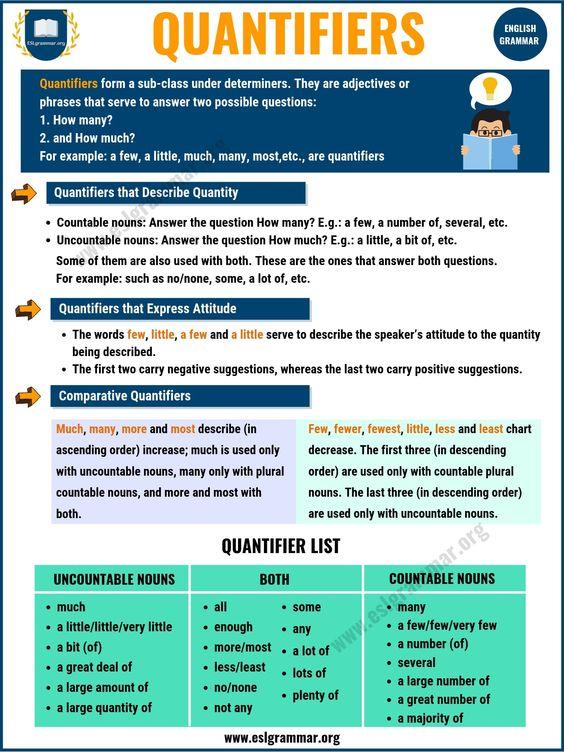What are quantifiers? We use quantifiers (A Lot Of, A Few, A Little, A Bit…) when we want to give information about the number of something: how much or how many. Let's take a look at it below.

Quantifier Definition
Quantifiers form a sub-category under determiners. They are adjectives or phrases that answer two possible questions:
1. How many?
2. and How much?
For example: a few, a little, much, many, most, some, any, enough, etc., are quantifiers.
How to Use Quantifiers
Quantifiers that Describe Quantity
Quantifiers that describe quantity include a little, none, a few, etc. Some of these are used only with:
Countable nouns – These are the nouns that answer the question "How many?"
For example: a few, a number of, several, etc.
Uncountable nouns – These are the nouns that answer the question How much?
For example: a little, a bit of, etc. )
Some of them are also used with both. These are the ones that answer both questions, for example: such as no/none, some, a lot of, etc.
Quantifiers that Express Attitude
The words few, little and the phrases – a few and a little serve to describe the speaker’s attitude to the quantity being described. The first two carry negative suggestions, whereas the last two carry positive suggestions. For example:
The sentence "I have little time" means that the speaker hardly has time, whereas the phrase "I have a little time" means that while the speaker may not have all the time in the world, but s/he has enough for the purpose at hand.
"Enough"
Enough is used to indicate the necessary amount or quantity; it is placed before nouns. For example:
- There is enough time,
- You have enough money,
- Is there enough food?
Comparative Quantifiers
There are ten comparative or grade quantifiers: much, many, more, most, few, fewer, fewest, little, less, and least.
Much, many, more and most describe (in ascending order) increase; much is used only with uncountable nouns, many only with plural countable nouns, and more and most with both.
I have much time. < I have more time. < I have the most time.
Few, fewer, fewest, little, less and least chart decrease. The first three (in descending order) are used only with countable plural nouns. The last three (in descending order) are used only with uncountable nouns.
He has few friends. > He has fewer friends. > He has the fewest friends.
Are you interested in teaching English as a foreign language?
Get your TEFL certification with ITTT.
Register now & get certified to teach english abroad!


